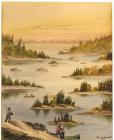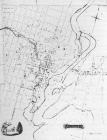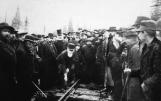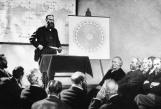14
Once Fleming settled, Dr. Hutchison set about helping him to find work surveying. He was able to secure for Fleming a letter of recommendation from Captain McDonald to Sir Allan MacNab in Hamilton.Sandford would make trips into Toronto and Hamiliton to make connections and look for work. When that proved fruitless he went to Caledonia where Henry had settled. He was able to find odd jobs here and there, but eventually decided that he was better off returning to Peterborough.
While some potential employers were discouraging, John G. Howard, the City Engineer for Toronto, advised him to write his surveyor's exams and establish his Canadian credentials.
Thursday August 21st 1845
"Wrote to Dr. Hutchison. The English mail came in today. I called on Mr Howard, Architect & Engineer here, but he does not require anyone. Tells me how to get License by surveying in the Bush &c."
Back in Peterborough Fleming became clerk in the general store of James Hall, an MPP and friend to Dr. Hutchison. Hall was a member of Legislative Assembly's railway committee and was able to provide Fleming his first introduction to railway builders.
15
Young Sandford Fleming19th Century, Circa 1845
Peterborough, Ontario, Canada
 Credits:
Credits:Hutchison House Museum, Peterborough, Ontario, Canada
16
While living with the Hutchisons, Fleming would help around the home and garden, digging an irrigation drain and building a stable. He attended the Scottish and English Churches (St. Andrew's and St. Johns, respectively) with the family, even drawing designs for the spire of the Catholic Church. He was constantly sketching the buildings around townOne year he made an electrifying machine for the church bazaar, which Dr. Hutchison later bought back.
Wednesday January 1st 1846
"It is now 365 days since I commenced to write a journal and it is as long since met with all my friends in my fathers house, instead of looking at the smoking turkeys on Dr. Hutchisons table. We skated almost all day. Got two fine clear glass bottles from the Dr. to make a electrifying machine to present to the Bazaar."
Tuesday January 13th, 1846
"Finished machine & took it to the Bazaar. It was bought in the evening at the auction by Dr. Hutchison for 15/. Sorry I did not give it to him at first. This Bazaar went very well, reports say they drew £150."
17
From Julian's Landing, Stoney Lake, Peterborough by Rev. Vincent Clementi19th Century, Circa 1871
Stoney Lake, Peterborough, Ontario, Canada
 Credits:
Credits:Hutchison House Museum, Peterborough, Ontario, Canada
18
Fleming often wrote of his travels with Dr. Hutchison as he attended his rounds throughout the county.Friday 20th June 1845
"David & I went with Dr Hutchison in a spring wagon up as far as Mud Lake a distance of 8 miles, calling at several farmers houses where he had patients along the way. About ½ this distance out from Peterboro is covered with good farms partly cleared. The houses are not fine but the farmers appear well off. Mud Lake is about 12 miles opposite side, Peter Nogey, chief."
Friday 27th June, 1845
"Went down in the steamer with Dr. Hutchison to Rice Lake where there is an Indian village. Got some stone arrowheads from a Miss Anderson, a half Indian...."
Wednesday January 8th, 1846
"Set off with Dr. Hutchison to Asphodel to see Mr. Birdsall. Got down about 8 miles when we were obliged to stop at coroners inquest upon the body of a lumberman who died in a shanty this morning, about the first dead man I have seen. Returned to Peterboro."
19
1846 Map of Peterborough done by Sandford Fleming2 June 1846
Peterborough, Ontario, Canada
 Credits:
Credits:Sandford Fleming
Hutchison House Museum, Peterborough, Ontario
20
In 1846, taking the advice of the John G. Howard, City Engineer for the City of Toronto, Fleming decided to do some surveying of the county.Fleming, who was working for his future father-in-law at his store, left to work for Richard Birdsall drawing a plan for a proposed road from Kingston to Ottawa and teaching his young sons to draw. He decided to augment his income by creating and selling his own maps of the area.
He borrowed Birdsall's compass and chain, hired a chain bearer and set out to map Peterborough. He went out in February and by May his plans were finished and he was looking for subscribers. Fleming took his plans to a new lithographer, Scobie & Balfour Lithographing Co. in Toronto. While he was waiting for his order to be completed he did odd jobs copying papers and sketching buildings.
February Monday 9th, 1946
"Commenced the survey with Donald Haggard chain bearer at 2/6 a day. The snow about 2 feet deep some places. Me drawing. Wrote David to send down things and clothes."
March Monday 15th - Wednesday 17th 1846
"At plans. My name appeared in the paper as an advertisement as Architect & Civil Engineer."
21
Sandford Fleming in the field on survey19th Century, Circa 1860
Canada
 Credits:
Credits:Hutchison House Museum, Peterborough, Ontario, Canada
22
Fleming moved to Toronto to continue his work as a surveyor. In 1849 he was a founding member of the Royal Canadian Institute, which was formally incorporated November 4th, 1851. In 1880 he was the President of the Ottawa Horticultural Society. Sandford was also a prominent advocate for the laying of the underwater Pacific Cable (telegraph cable) connecting the British Empire. This dream would be realized in 1902. Sandford was knighted by Queen Victoria in 1897 and was president of the Royal Society of Canada from 1888-1889.23
Sketch of his wife Anne Jean Hall by Sandford Fleming19th Century, Circa 1855
Toronto, Ontario, Canada
 Credits:
Credits:Queen's University Archives, Kingston, Ontario
24
Sandford Fleming was a romantic, and while he had met future wife Ann Jane (Jeanie) Hall while in Peterborough soon after his arrival in Canada (he was 18 and she was 14), it wasn't until a chance encounter during an 1854 visit to Martha Hutchison that their love would start to grow. After a year-long courtship they were married in Peterborough in January of 1855 and had nine children (7 survived).25
Sandford Fleming and the driving of the Last Spike7 November 1885
Craigellachie, British Columbia, Canada
 Credits:
Credits:Hutchison House Museum, Peterborough, Ontario, Canada
26
Many of Fleming's achievements are recognized by historical plaques across both Canada and Scotland, in locations such as Peterborough, Halifax, Toronto, and Ottawa in Canada, as well as Kirkaldy and Fifeshire in Scotland.One of Fleming's greatest achievements was surveyor for the Canadian Pacific Railway. Built between 1881 and 1885, the CPR connected Canada from coast to coast. Fleming was present at the driving of the last spike in November 7, 1885.
Fleming also did surveying for the Grand Trunk Railway, was Chief Engineer for Northern Rail of Canada in 1855 and was a strong advocate for the construction of iron railway bridges.
27
Sandford Fleming at the Royal Canadian Institute Meeting pitching Standard Time8 February 1879
Greenwich, England
 Credits:
Credits:Confederation Life Collection